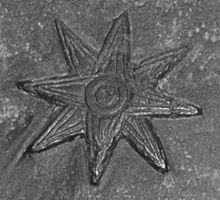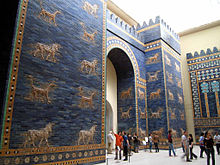Ishtar
![]()
This article is about the Mesopotamian goddess Ištar. For the Arabic unit of weight, see Istār.
Ištar, Sumerian Inanna (Sumerogram: ![]()
![]() dMÙŠ), is the Akkadian name of a deity worshipped in Mesopotamia. Many different attributes and numerous temple buildings were attributed to her. The Ištar Gate in the walls of Babylon has gained special fame through its reconstruction in the Pergamon Museum (Berlin).
dMÙŠ), is the Akkadian name of a deity worshipped in Mesopotamia. Many different attributes and numerous temple buildings were attributed to her. The Ištar Gate in the walls of Babylon has gained special fame through its reconstruction in the Pergamon Museum (Berlin).
The planet Venus is assigned to this deity. She was worshipped as a goddess of (sexual) desire as well as a war deity. She was considered the daughter of Sin and sister of Šamaš. Some consider her to be the most difficult goddess of the Sumerian and Akkadian pantheon to grasp because of her multifaceted and multi-layered figure, for others Ištar represents a paradox, since - according to today's understanding - she combines contradictory qualities in the same person.

Star symbol of the Ištar from a kudurru of the Meli-Šipak
Name
The ancient Near Easternist Claus Wilcke traces the Akkadian name Ištar back to the Common Semitic name ʻAṯtar. The nominative plural form ištaratu denoted the concept of femininity.
Circulation
Babylonia
Ištar was the most important Babylonian goddess. She was worshipped as both the morning and evening star. Ištar can appear in both male and female form. Her symbolic animal is the lion, and one of her epithets is therefore labbatu (lioness). Another animal associated with Ištar is the jackal. One hymn proclaims, "A jackal on a lamb hunt art thou!" Her divine servants were Ninatta, Kulitta, Sintal-irti, and [H]amrazunna; her "last" servants were Ali, Halzari, Taruwi, and Šinanda-dukarni.
In the Museum of the Ancient Near East (Pergamon Museum) in Berlin, the Ishtar Gate, one of the gates of Babylon, can be seen with the processional way leading up to it. Its walls are decorated on each side with 60 lions, the symbolic animals of Ištar.
Assyria
Ištar was also one of the most important goddesses in Assyria as Ištar-Aššuritu. She was considered the founder of Nineveh and the wife of Aššur. Already in ancient Assyrian times Ištar had an important temple in Aššur.

Ishtar Gate in the Pergamon Museum in Berlin

Detail of a lion, symbol of the goddess Ishtar, at the procession road to the Ishtar Gate
Search within the encyclopedia